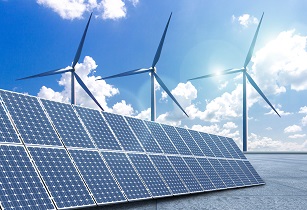The heightened focus on energy security and the rising cost of energy is reinforcing the difference in decarbonisation speed between Europe and the rest of the world, according to DNV’s Energy Transition Outlook
Europe will prioritise renewables and energy efficiency to increase its energy independence. European gas consumption will fall dramatically as a result of the war in Ukraine. Compared to last year’s forecast, DNV sees the continent consuming almost half the amount of natural gas in 2050.
Lower-income countries see a different trend, as cost mainly drives energy policy. High energy and food prices are reversing the coal-to-gas switch, thus putting a dampener on decarbonisation investments.
Moreover, inflationary pressures and supply chain disruption pose a slight challenge to renewable growth. DNV’s Outlook states the global electric vehicle (EV) ‘milestone’ has been delayed by one year to 2033.
However, the devaluing of renewables and increased carbon costs in the longer term take precedence over the current crisis on the overall energy transition.
“The turbulence in the energy market does not dramatically alter the decarbonisation pathway towards mid-century,” said Remi Eriksen, group president and CEO of DNV. “The strongest engine of the global energy transition is the rapidly reducing costs of solar and wind energy, which will outweigh the present short-term shocks to the energy system.”
For the first time, DNV’s forecast sees non-fossil energy go above 50% of the global energy mix by 2050, owing to the growing and greening of electricity production. Solar PV and wind are already the cheapest form of electricity in most locations, expecting to see substantial growth, dominating electricity production with 38% and 31% shares, respectively. Renewables expenditure is anticipated to double over the next 10 years to more than US$1,300bn per year, and grid expenditure is likely to exceed US$1,000bn per year in 2030. Energy security concerns are leading to renewed interest in nuclear, and the forecast this year reflects a modest uptick, growing by 13% from today’s levels to 2050. However, its share of the electricity mix will still reduce from to 5% from 10% by 2050 compared with 25% today.
The short-term increase of coal consumption will not prevent it from rapidly exiting the energy mix, peaking in 2014. Oil has been approaching a plateau for some years and is expected to decline sharply from 2030 onwards. Before the war in Ukraine, DNV forecast natural gas would be the single largest energy source by the end of this decade, but this has been delayed to 2048.
Pathway to Net Zero
The Outlook this year also includes the Pathway to Net Zero, which is DNV’s most feasible route to being on target and limiting global warming to 1.5°C. Global CO2 emissions reduction of 8% every year is required to reach net zero by 2050. In 2021, emissions were rising steeply, approaching pre-pandemic all-time highs, and 2022 may only show a 1% decline in global emissions. That makes for two ‘lost’ years in the battle against emissions.
The goal of net zero varies between sectors, with electricity production requiring net zero before 2050, whilst cement and aviation will still have remaining emissions. The maritime sector would be required to reduce emissions by 95%.
According to the Pathway to Net Zero, no new oil and gas will be needed after 2024 in high income countries, and after 2028 in middle and low-income countries. Investments in renewables and grid need to scale much faster; renewables investment needs to triple and grid investment must grow by more than 50% over the next 10 years.
DNV’s Pathway to Net Zero calls for greater policy intervention than we see today.
Middle East Outlook
The report also included a regional breakdown for the outlook of the Middle East, highlights include:
− Both KSA and UAE target 40-50% of their energy from renewables in 2030 (and net zero by 2016 and 2050 respectively). Morocco aims for 52% renewable power by 2030, Egypt 42% by 2035, and Turkey’s 50% target by 2023 is likely raised as 66% was already achieved in 2020.
− Rising electricity demand will place focus on average energy efficiency and demand side-management measures.
− The region is expected to exploit its lowest per-barrel extraction costs with continued investment in upstream oil and gas production and liquefaction capacity. Maintaining oil-supply shares to maximize government revenue will be in focus and succeeding.
− The UAE and KSA governments pursue joint funding in hydrogen industrial partnerships. Morocco expects cumulative hydrogen investments of US$8bn by 2030 and US$75bn by 2050. Oman targets US$34bn in renewable-hydrogen investments by 2040. Egypt is emerging as an export hub for LNG, electricity, and green ammonia. The UAE and KSA also target domestic use in industry and road transport. This solidifies DNV’s forecast of reaching over 50% on non-fossil energy by 2050.





